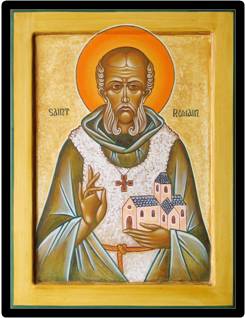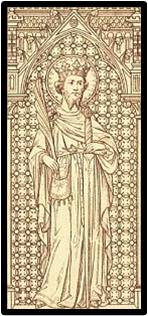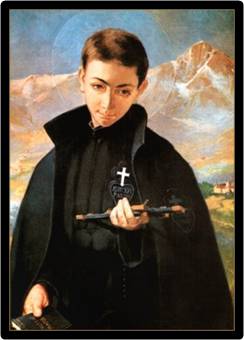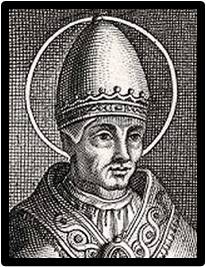
These French saints were brothers. Everyone who knew St. Romanus as a youth admired him for his goodness. He had a great wish to become a saint. Since he saw that it was very easy to forget about God in this world, at the age of thirty five, Romanus decided to go away to a quiet place and live as a hermit.
First, he asked the advice of a holy monk, and then he started off. He took a book with him called The Lives of the Fathers of the Desert by Cassian. He also took seeds to plant and a few tools.
With these supplies, he went into the forests of the Jura mountains between Switzerland and France and settled down beneath a huge fire tree at a place called Condat. There he found a spot of land good for growing his garden and food, and some trees from which he could eat a kind of wild fruit. He spent his time praying and reading his book. He also planted and cared for his garden, quietly enjoying nature.
Soon afterward, his brother Lupicinus joined him. Romanus and Lupicinus were very different. Romanus was hard on himself but he was kind and gentle and full of understanding with others. Lupicinus was tough and very strict with himself and usually the same with others but he only meant good and did not do it to hurt anyone. The two brothers understood each other and got along peacefully.
Many men came to join them. They wanted to be monks, too, so they built two monasteries. Romanus was the abbot of Condat (now Saint Claude) and Lupicinus was the abbot of Leuconne. Later they built the convent of La Beaume for nuns (now St. Romain de la Roche).
The monks lived simple, hard lives. They ate simple food which was mainly bread made of barley or bran and pulses and slept on the ground or on hard boards. St. Lupicinus wore a tunic made of skins of animals with a cowl: and wore wooden shoes.
They prayed much and made sacrifices cheerfully. They did penance to strengthen themselves against the temptations of the devil. They worked very hard farming to grow their food and kept silent all the time.
They lived like this because they wanted to grow close to God and when they were silent they were able to pray and talk with God. Their lifestyle helped them become more holy.
St. Romanus died in 460 and was buried at the abbey of Beaume. His younger brother, St. Lupicinus, died in 480.

Count Charles of Flanders was called “the good” by the people of his kingdom because he truly was good. He was the son of St. Canute, king of Denmark who was killed when Charles was just five years old. He was raised by his maternal grandfather, Robert de Frison who was then the Count of Flanders.
When Charles grew up, he married a good young woman named Margaret. Charles was a gentle and fair ruler. The people trusted him and his laws. He tried to be a good example for his people to follow.
Some nobles blamed Charles for showing more favor to the poor than the rich. He kindly answered them saying, “It is because I am so aware of the needs of the poor and the pride of the rich.” Everyday, the poor and hungry in his kingdom were fed at his castles.
Charles ordered for plenty of crops to be grown so that the people would have sufficient to eat at prices they could afford. Some rich men tried to store grain to sell later at very high prices. When Charles found out he forced them to sell immediately and at fair prices.
An important man and his sons had been scolded by Charles for their unkind plans to hurt the poor. They felt insulted and joined the little group of enemies who now wanted to kill Charles.
Every morning Charles walked barefoot to Mass, as an act of penance and arrived early at the Church of St. Donatian at Bruges by Borchard. He wanted with all his heart to have a closer and deeper relationship with God. His enemies knew that he walked to church and also that he often prayed alone before Mass.
The people who loved Charles feared for his life. They warned him that his walks to St. Donatian could be dangerous. He replied, “We are always in the middle of dangers, but we belong to God.” One morning in 1127, as he prayed alone before the statue of Mary, his enemies finally managed to kill him.




